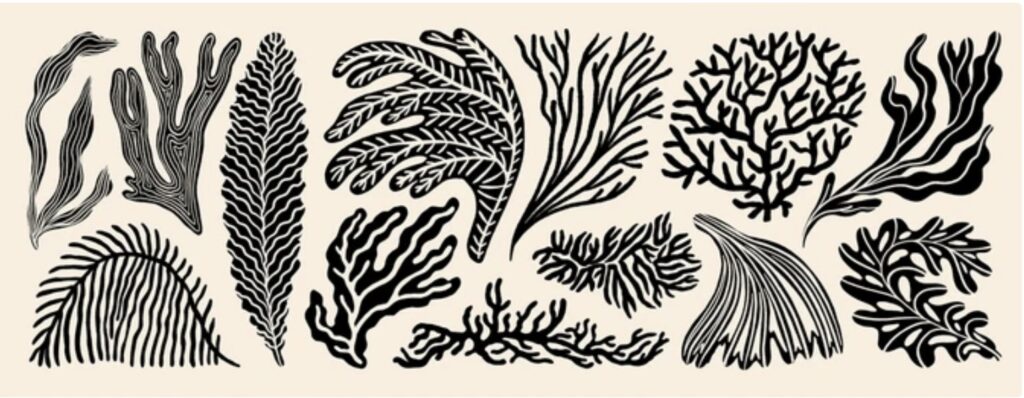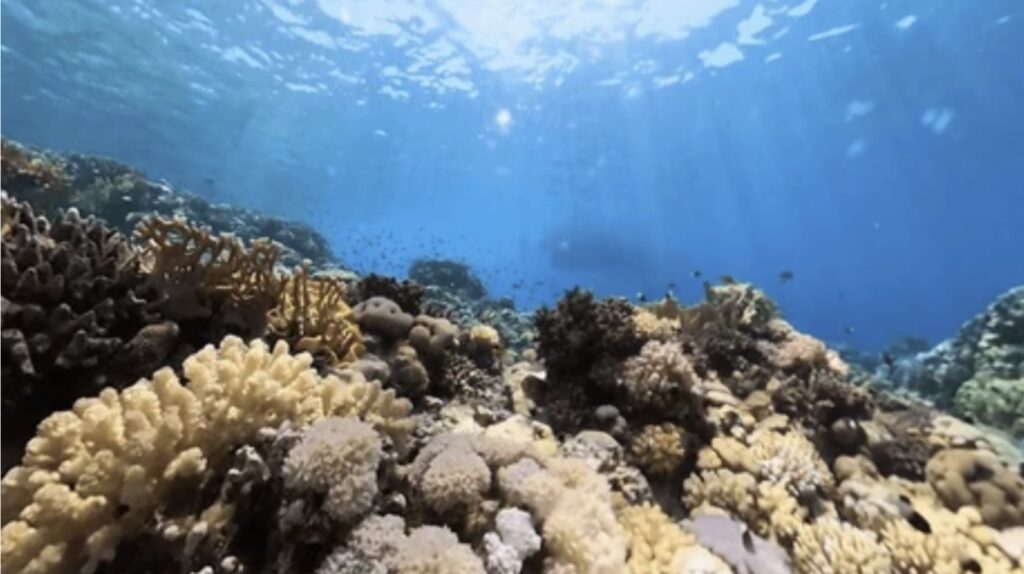Introduction
CORAL REEFS AND THEIR TYPES: Coral reefs are some of the most diverse and vibrant ecosystems on the planet. Often referred to as the “rainforests of the sea,” they provide essential habitats for a wide array of marine life, including fish, invertebrates, and other marine organisms. Beyond their biodiversity, coral reefs also offer critical ecological services, such as protecting coastlines from erosion, supporting fisheries, and promoting tourism. However, these delicate ecosystems are under growing threat from climate change, pollution, and overfishing, making the study and conservation of coral reefs more important than ever.
What Are Coral Reefs?

Coral reefs are large, underwater structures made from the calcium carbonate skeletons of tiny marine animals called coral polyps. These polyps are part of the phylum Cnidaria, the same group that includes jellyfish and sea anemones. Coral polyps live in colonies and secrete an exoskeleton made of calcium carbonate, which over time accumulates to form the massive, solid reef structures we recognize as coral reefs.
The majority of coral reefs are located in tropical and subtropical waters, typically between 30°N and 30°S latitude, where the water is warm (between 20-30°C or 68-86°F). They thrive in clear, shallow waters with plenty of sunlight, which is essential for the process of photosynthesis carried out by the zooxanthellae – tiny symbiotic algae that live inside the coral tissues. These algae provide corals with food and energy, while the corals provide the algae with a protected environment and access to sunlight.
Importance of Coral Reefs
- Biodiversity Hotspots: Coral reefs are among the most biologically diverse ecosystems on Earth. They are home to thousands of species of fish, corals, mollusks, crustaceans, and other marine organisms, many of which are found nowhere else.
- Coastal Protection: Coral reefs act as natural barriers, reducing the impact of waves and storms on coastal areas. This protects shorelines from erosion, property damage, and loss of life.
- Economic Value: Coral reefs support billions of dollars in tourism, fishing, and other marine industries. They are also critical for the livelihoods of millions of people around the world.
- Carbon Sequestration: Coral reefs play a role in carbon cycling by absorbing and storing carbon dioxide, helping mitigate climate change.
However, coral reefs are increasingly threatened by human activities, including global warming, ocean acidification, overfishing, and pollution. The impact of these threats is evident in the widespread phenomenon of coral bleaching, where corals expel their symbiotic algae in response to stress, leading to the loss of their color and, in many cases, their survival.
Types of Coral Reefs

Coral reefs can be classified into four main types based on their structure and location: fringing reefs, barrier reefs, atolls, and patch reefs. Each type has unique characteristics and can be found in different geographical settings.
1. Fringing Reefs
Fringing reefs are the most common type of coral reef and are found directly along the coastlines of continents and islands. These reefs are typically located in shallow waters, often just a few meters deep, and are closely associated with land. Fringing reefs are usually separated from the land by a shallow lagoon or intertidal zone.
Characteristics:
- Proximity to shore: Fringing reefs are directly attached to the shore or separated by a narrow lagoon.
- Shallow waters: They are found in shallow water, often near the coastline, making them highly vulnerable to changes in water quality and temperature.
- Formation: Fringing reefs form by the accumulation of calcium carbonate from coral polyps in shallow waters. As coral colonies grow, they build up reef structures that are exposed to the influence of waves and tides.
Examples:
- The Great Barrier Reef in Australia, although primarily a barrier reef, contains many fringing reef systems near the coast of Queensland.
- The Hawaiian Islands also feature numerous fringing reefs.
2. Barrier Reefs
Barrier reefs are larger and more complex than fringing reefs. They are typically located farther from the shore, separated by deeper, wider lagoons. Barrier reefs can stretch for hundreds of kilometers and are often more developed than fringing reefs.
Characteristics:
- Distance from shore: Barrier reefs are separated from the land by deeper waters, often with a lagoon between the reef and the coast.
- Larger size: Barrier reefs tend to be larger and more extensive than fringing reefs.
- Well-defined structure: Barrier reefs usually have a clear, well-defined structure with a reef crest, a lagoon, and a slope.
Examples:
- The Great Barrier Reef off the coast of Queensland, Australia, is the largest and most famous example of a barrier reef. It spans over 2,300 kilometers and is made up of over 2,900 individual reefs.
- The Belize Barrier Reef in the Caribbean is another notable example, extending along the coast of Belize.
3. Atolls
Atolls are circular or oval-shaped coral reefs that encircle a lagoon, with no land in the center. Atolls form when a volcanic island sinks or erodes over time, leaving behind a ring-shaped reef around a lagoon. These reefs are often found in the open ocean and are typically located in tropical or subtropical regions.
Characteristics:
- Ring-like structure: Atolls are characterized by a central lagoon surrounded by a ring of coral reefs.
- Formation: Atolls typically form over submerged volcanic islands. As the island erodes or sinks, corals continue to grow upward, eventually creating a circular reef structure around the lagoon.
- Isolated location: Atolls are usually found in remote oceanic locations, far from continental landmasses.
Examples:
- The Maldives in the Indian Ocean is a famous group of atolls, with over 1,000 coral islands forming the archipelago.
- The Kwajalein Atoll in the Pacific Ocean is one of the largest atolls in the world.
4. Patch Reefs
Patch reefs are smaller, isolated coral reefs that are scattered in lagoons or along the outer edge of larger reef systems. These reefs are often found in shallow waters and are not as extensive as fringing or barrier reefs.
Characteristics:
- Small size: Patch reefs are smaller than the other types of reefs and often exist as isolated patches or clusters.
- Shallow depths: They are found in shallow waters, often in lagoons, bays, or between larger reef systems.
- Localized growth: Patch reefs tend to form in areas where conditions are suitable for coral growth but do not cover large expanses.
Examples:
- The Florida Keys contain several patch reefs located within the Florida Reef Tract.
- The Andros Barrier Reef in the Bahamas has numerous patch reefs scattered throughout its waters.
Conclusion
Coral reefs are not only beautiful and diverse ecosystems, but they also play a vital role in supporting marine biodiversity and protecting coastal communities. The four main types of coral reefs—fringing reefs, barrier reefs, atolls, and patch reefs—each have unique characteristics and play different ecological roles in the marine environment.
However, coral reefs face increasing threats from human activities and climate change. Understanding the types and functions of coral reefs is essential for their conservation. Efforts to protect and restore these ecosystems are crucial for maintaining the health of our oceans and the livelihoods of those who depend on them.
Discover more from ZOOLOGYTALKS
Subscribe to get the latest posts sent to your email.



Pingback: PHYLUM ECHINODERMATA - CHARACTERSTICS, CLASSIFICATION | 2024
Pingback: SEAHORSE: CHARACTERISTICS AND FUN FACTS | ZOOLOGYTALKS | 2025